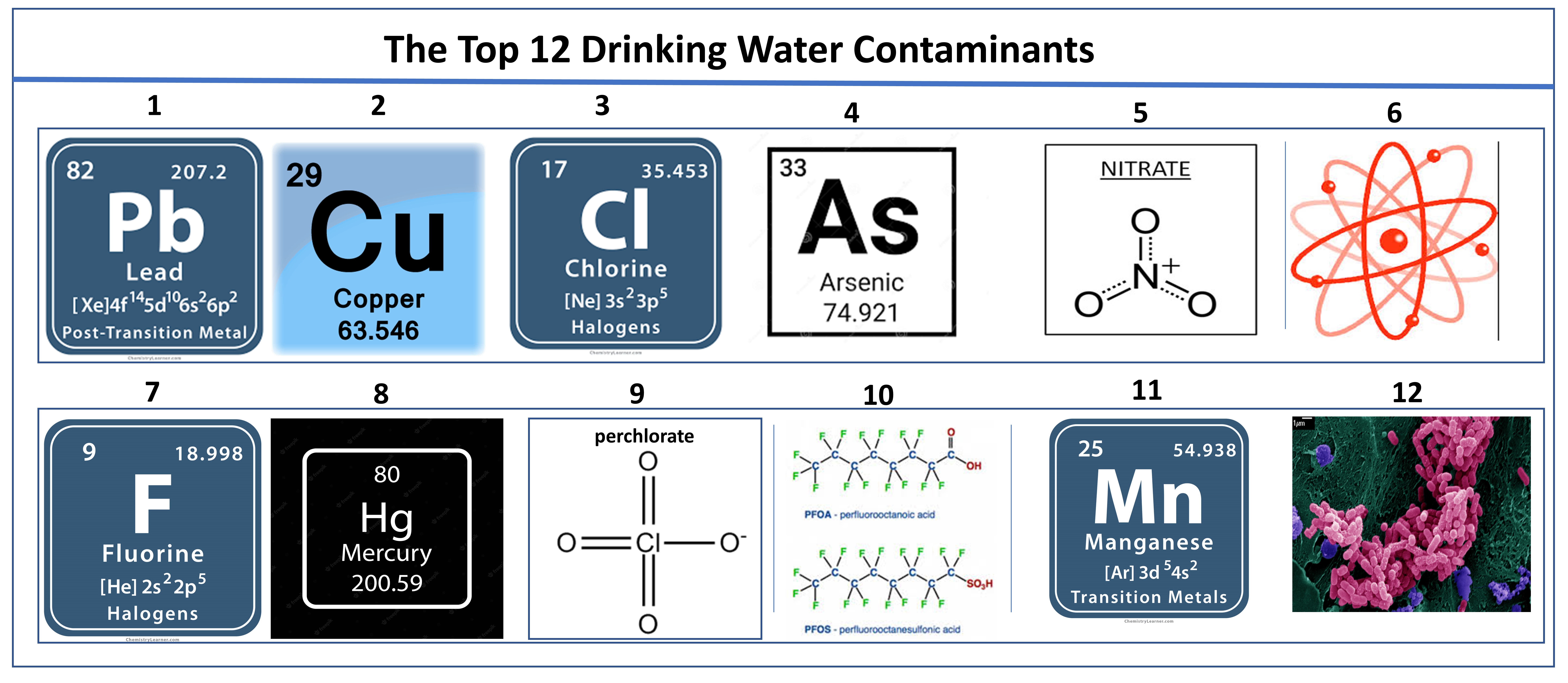The Top 12 Drinking Water Contaminants

- 1.Lead- from older plumbing systems pre-1986, when lead pipes, solder, and components were banned. Lead is a danger at all levels to children, affecting neurological development. In adults, low lead levels can affect neurological function and cause reproductive issues.
- 2.Copper- as copper pipes age or in contact with acidic water they can deteriorate. If green coloring is noticed in drains you may have high copper levels in your water, although not usually considered a problem in low concentrations, higher levels can cause anemia, liver, and kidney damage.
- 3.Chlorine- while used in the disinfection of drinking water, it can form trihalomethanes and haloacetic acids, which have been linked to cancer, kidney damage, and metabolic diseases.Chlorine levels up to 4 milligrams per liter (mg/L or 4 parts per million (ppm)) are considered safe in drinking water.
- 4.Arsenic- is a naturally occurring element and found throughout the US, particularly in the Southwest, the West coast, the Great Lakes region, and in agricultural areas where water pumping and irrigation is common. Arsenic can cause metabolic diseases, cancer, diabetes, and cardiovascular disease.
- 5.Nitrates- these chemicals enter the water supply through fertilizers, waste facilities, and from septic systems improperly designed. Infants and children are vulnerable to the effects of nitrates, reducing oxygen levels and causing methemoglobinemia “Blue Baby Disease”, which can cause respiratory, digestive, neurological issues and even death.
- 6.Radionuclides- Include uranium, radium, thorium, and radon, and while found in nature, can result in exposure from construction, mining, petroleum, and gas production. Exposure to radium can cause cancers and sarcomas, while other radionuclides can lead to cancers of the organs, skin, thyroid, and neurological system, including gliomas.
- 7.Fluoride- this anion is useful for preventing tooth decay, and salt forms such as sodium fluoride and sodium monofluorophosphate are used in dentistry and added to about 66% of the US water supply as a preventative measure. While sodium fluoride was used to fluoridate water; hexafluorosilicic acid (H2SiF6) and its salt sodium hexafluorosilicate (Na2SiF6) are typically used in the US. Not innocuous, high levels of fluoride in the drinking water lowered IQ scores in children, the World Health Organization found fluoride can cause muscle impairment and joint pain and stiffness. An estimate called the Adequate Intake (AI) has been adopted and for women 19 yeqars and older is 3.0 mg/day, men is 4.0 mg/day, and for children 1-18 increases from 0.7 to 3.0 mg/day. The tolerable upper limit of intake is 10.0 mg/day. Tooth decay is decreased when used in drinking water at 0.7 mg/liter, the recommended level, although older ranges were 0.7 to 1.2 mg/liter.
- 8.Mercury- most exposure is due to household sources, paints, and through industrial sites by ground water diffusion or through smokestack emissions. Mercury accumulates in the body, and can slowly damage the neurological systems, circulatory system, kidneys, while affecting development in fetuses and children.
- 9.Perchlorate is the anionic component of numerous salts used in rocket fuels, pyrotechnics, fireworks and as cleaners for metal surfaces in metallurgical process. About 5% of the current population of the US has been exposed to perchlorates, and they are toxic to children and pregnant women, linking to neurological development issues.
- 10.PFOA-perfluorooctanoic acid and perfluorooctansulfonic acid (PFOS, also called PFOAs)- is the non-stick chemical found in Teflon cookware, and in polymeric Teflon used in construction materials. It is labelled as indestructible, an organopersister, and has been found all over the world in water supplies, arctic and Antarctic locations, and in the bloodstreams of most individuals tested worldwide.There is increasing evidence that PFOAs can cause a variety of health issues, from metabolic disorders, neurological issues, to infertility. In wild animals, PFOs have been found in extreme levels in predators, game birds and marine life, where they are considered to alter the health parameters sufficient to cause immunosuppression.
- 11.Manganese- usually manganese is ingested in foods (whole grains, clams, oysters, mussels, nuts, soybeans and other legumes, among an extensive list) although public drinking water in the US may contain up to 300 parts per billion (0.6 mg/liter of water) in some geographic locations. Toxicity due to over-exposure, called Manganism, can cause neurological disease similar to Parkinsonism, including trembling, motor difficulties, stiffness, and behavior changes related to depression, hostility, and anxiety.
- 12.Microorganisms- viruses, parasites, bacteria, coliforms including E. coli and thermotolerant E. coli, can cause many differentiated illnesses. Routine testing for coliform bacterial contamination in the case of Escherichia coli is done to determine if there is a point source of bacterial contamination, while viruses and other pathogens may be present.
14th Dec 2022
Recent Posts
-
Disinfecting Surfaces in the Era of Covid and EPA Registered Commercial Disinfectants and Viricides
The disinfection of surfaces at home, in public spaces, and in hospitals and clinics needs to be a …15th Jan 2023 -
Working with Inorganic Acids in the Laboratory: A Practical Guide
Working with Inorganic Acids in the Laboratory Acids are of great importance in the laboratory and a …5th Jan 2023 -
The Top 12 Drinking Water Contaminants
1.Lead- from older plumbing systems pre-1986, when lead pipes, solder, and components were banned. …14th Dec 2022
